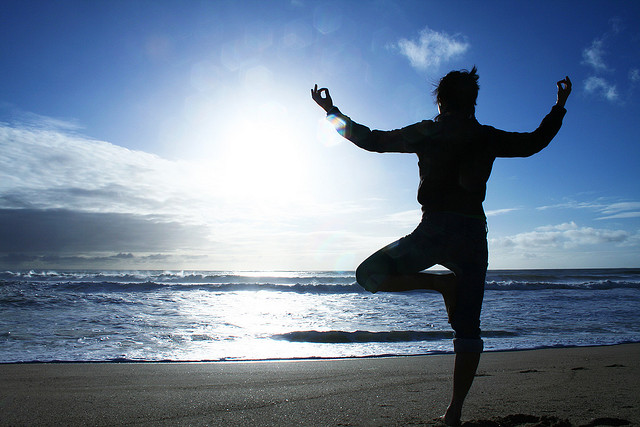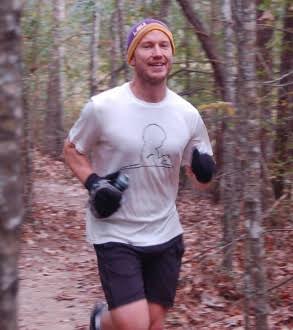Sometimes after a yoga session I feel 20 years younger. It is the most energizing practice I have ever tried and it has helped my running tremendously.
This flexibility makes me feel phenomenal, every movement feels easier and I move with a sensation of lightness. It also gives me the ability to lift heavy things with better form and avoid injuries.
But there isn’t any real evidence that becoming more flexible or stretching more helps you run any faster or prevents injuries during running. In sprinting, static stretching before running has been show to slow you down. But this is no reason to skip yoga.
If you’re a runner, here are the real reasons to practice yoga:
Reason 1: Better Breathing.
Breathing is the most important movement that supports all of our other movements, including running. Yoga is primarily a breathing exercise that challenges our breathing in different ways though different poses and as a result we develop the ability to breathe better through any challenge.
A great way to implement this is through a method called ujjayi breathing. If you develop the ability to breathe better, you will run easier and faster through fatigue and discomfort.
Try this: Sit tall and close your eyes. Breathe through your nose and begin to gently narrow the back of your throat so that your breath produces a slight hiss or sigh. Keep your mouth closed and draw your breath so deep you feel it in the lower abdomen and pelvic floor.
Reason 2: Learning to Relax.
Most runners carry excess tension in their bodies. This slows us down by increasing our internal resistance to blood flow throughout our body and our heart has to work harder to pump blood through tense muscles.
You can easily prove this to yourself by running with a heart rate monitor and finding an easy pace where your heart rate levels out. Then clench your fists and tense your arms and shoulders for one minute and maintain the same speed.
Your heart rate will increase immediately and it will feel harder to maintain the same speed. But the opposite is also true—if you can learn to relax your arms, hands and shoulders while running, you will go faster and farther with less effort.
Try this: Close your eyes and breathe through your nose. Notice any areas of your body holding tension. Visualize and feel each inhalation going to that area where you feel tension and as you exhale, visualize the tension dissolving and your breath carrying the tension out of your body.
Reason 3: Strength Exactly Where You Need It.
A large part of yoga practice includes poses where we are balancing our entire body on one leg for an extended period of time. These postures strengthen the system of muscles and connective tissue that absorb ground impact forces with each step.
Ground impact force can be more than 3 times your body weight with each step. With more than a thousand steps per mile, this impact adds up.
Anything that strengthens the muscular and connective tissue system that absorbs these forces will help prevent injuries and make you faster.
Try this: Stand tall barefoot. Slowly lift one foot and find balance on the standing leg. Continue with the ujjayi breathing method from above and find a focal point for your eyes, preferably something that is not moving. Try to hold this for five breathes on each leg. Over time, progress to holding this position longer and longer.
Reason 4: Better Mindset.
A huge part of the philosophy of yoga is non-attachment to outcomes and focusing on the process. Modern sport psychology also points to this habit as a practice of top performers in all sports. Cultivating this mindset is hugely beneficial to a long distance runner who needs to endure the grind of miles and miles of running.
In yoga practice, we get into initially uncomfortable positions and use calm slow breathing to make peace with the discomfort. Eventually, we develop the skill of embracing what is uncomfortable and breathing through each experience.
This carries over into running when you reach a speed that is initially uncomfortable. Rather than fighting it and creating excess tension thereby making it harder, you learn to relax and embrace it, calming your body through breathing and finding a level of serenity within the intensity.
Try this: With the one leg balance exercise above, set a timer for a time that seems nearly impossible. It may be one minute to start. Then hold that posture while focusing on your breath and the sensations in your body. When your mind wanders, consciously bring attention back to your breath and your body.
Reason 5: Movement Variety.
If specific movements were nutrients, most runners would be on a severely unbalanced diet. Just as it’s not ideal for your body to get 80 percent of its calories from one food source, it’s not optimal for one movement pattern to provide most of your movement.
We need an extremely large variety of movements for our bodies to thrive. Overdoing one movement pattern without enough variety will eventually lead to imbalances and injuries. Yoga practice provides a very complete movement practice–we slowly and gently explore the many options of movement your body can perform. This exploration helps all our body’s muscles and connective tissues to remain strong.
This large variety of movements also creates better mind-body connection. Better movement and body awareness allows us to learn to move in a more efficiently and less damaging way.
Try this: Stand tall and spread your feet as wide as possible without feeling a painful level of stretch, maybe around three or four feet apart. Be sure your feet are parallel. Inhale and reach above your head with both arms. Exhale and fold over at your hips and reach for the ground. Inhale and exhale once in this position. Then inhale and stand up while reaching your arms above your head. Exhale and remain standing as you allow your arms to float back down by your sides.
~
Author: Nick Ortego
Editor: Katarina Tavčar
Photo: Mish Sukharev/Flickr











Read 1 comment and reply